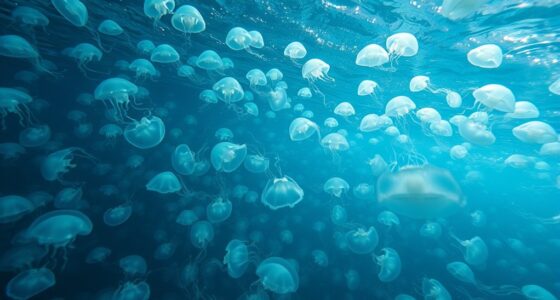Desert beetles harvest water from thin air by using specially structured surfaces that maximize condensation. Their bodies have a pattern of hydrophilic areas that attract moisture and hydrophobic zones that guide droplets toward their mouths. They take advantage of nighttime humidity increases, tilting their bodies to help gravity transfer the collected water. This natural strategy can inspire innovative water-harvesting technologies; keep exploring to discover how scientists are applying these ideas.
Key Takeaways
- Desert beetles have specialized surface structures with hydrophilic and hydrophobic areas that promote moisture condensation.
- They exploit increased nighttime humidity to collect water vapor from the air.
- Condensed water droplets are guided toward the beetle’s mouth using surface patterns and gravity.
- Their body tilts in the morning to facilitate efficient water transfer into their mouth.
- Scientists mimic these natural structures to develop water-harvesting technologies for arid environments.

In the harshest desert conditions, some beetles have developed a remarkable way to survive: they can harvest moisture directly from the air. This extraordinary ability is a prime example of drought resistant adaptations that allow these insects to thrive where water seems almost nonexistent. Instead of relying on underground sources or rare rainfalls, these beetles use a specialized strategy to extract water from the thin, humid air around them. Their bodies are equipped with unique surface structures that maximize condensation, turning invisible moisture into life-sustaining droplets. This natural innovation has inspired scientists to develop insect-inspired technologies aimed at addressing water scarcity issues in arid regions worldwide. Additionally, their ability to efficiently utilize minimal humidity highlights the importance of biological adaptations in extreme environments.
Desert beetles harvest moisture from air using unique surface structures, inspiring innovative water collection technologies.
The beetle’s back features a distinct pattern of hydrophilic and hydrophobic surfaces. The hydrophilic areas attract water vapor, encouraging it to condense into droplets, while the surrounding hydrophobic zones help guide these droplets towards the beetle’s mouth. As the temperature drops at night and humidity increases, these surfaces work together to capture moisture efficiently. When the morning sun rises, the beetle tilts its body, allowing gravity to help move the collected water into its mouth, providing a crucial hydration source. This method is highly effective even in environments with minimal humidity, showcasing an incredible drought resistant adaptation that enables survival in extreme desert conditions.
Scientists have been studying these beetles to reveal bio-inspired solutions for water collection technology. By mimicking the surface microstructures of the beetle’s back, engineers are creating new materials and devices that can harvest water from the air in places where traditional methods fail. These insect-inspired technologies include innovative fog nets, condensation collectors, and water-harvesting surfaces that mimic the beetle’s ability to condense moisture efficiently. Not only do these advancements hold promise for improving life in desert communities, but they also demonstrate how nature’s adaptations can inspire sustainable solutions to global water challenges.
Understanding how desert beetles harvest water reveals the profound potential of drought resistant adaptations. Nature often provides elegant blueprints for solving human problems, and these insects exemplify resilience and ingenuity. Their ability to extract moisture from seemingly dry air underscores the importance of studying biological systems to develop innovative, eco-friendly technologies. As climate change intensifies and water scarcity worsens, the lessons from these desert-dwelling beetles could be pivotal in creating practical, scalable solutions. Harnessing the principles behind their natural water collection methods might lead to breakthroughs that help millions access clean water, even in the most unforgiving environments.
Frequently Asked Questions
How Much Water Can Desert Beetles Collect Daily?
You’re wondering about desert beetles’ water efficiency and their daily water intake. These beetles can collect roughly 0.1 to 0.2 milliliters of water per day, thanks to their specialized shell. Their water collection process is highly efficient, allowing them to survive in arid environments. While it might seem small, this amount is enough for their hydration needs, showcasing nature’s remarkable adaptation to extreme conditions.
Do Desert Beetles Conserve Water Efficiently?
You might wonder if desert beetles conserve water efficiently. They excel at water conservation through unique beetle adaptations, like a tough, waterproof shell that minimizes water loss. Their behaviors also help reduce dehydration, such as staying in shaded areas during peak heat. These adaptations enable them to survive in harsh desert conditions by efficiently managing their limited water resources, making them true masters of water conservation in arid environments.
Can Humans Replicate Beetle Water Collection Methods?
You can explore biomimicry innovations inspired by desert beetles to develop sustainable water solutions. By studying their water collection methods, you might create surfaces that condense moisture efficiently from the air. These technologies could help address water scarcity issues, making water harvesting more sustainable and accessible. While replicating beetle techniques isn’t straightforward, ongoing research shows promising potential for humans to adapt these natural strategies for reliable, eco-friendly water sources.
Are Desert Beetles Affected by Climate Change?
You might be surprised, but climate change does impact desert beetles, altering their migration patterns and threatening their survival. Studies show that shifts in temperature and humidity can disrupt their usual behaviors, affecting the desert ecosystem impacts they help sustain. As conditions become more extreme, beetles struggle to find water and suitable habitats, risking decline. This change highlights how climate change directly influences even tiny creatures vital for ecological balance.
How Do Beetles’ Water-Harvesting Abilities Evolve?
You might wonder how beetles’ water-harvesting abilities evolve. Through evolutionary adaptations, their bodies develop features that maximize water collection. Genetic mutations play a vital role, introducing variations that can enhance these traits over generations. As environmental pressures favor efficient water gathering, natural selection promotes traits like textured shells or specialized surfaces, enabling beetles to survive in arid climates by better utilizing moisture from the air.
Conclusion
By studying desert beetles, you learn that nature’s solutions are often simple yet brilliant. Their ability to harvest water from thin air shows you that even in the harshest conditions, innovation thrives—much like discovering a hidden Wi-Fi signal in a forgotten cave. If these tiny creatures can survive by turning air into life, so can you adapt and find your own ways to thrive, no matter how dry or challenging the landscape.









